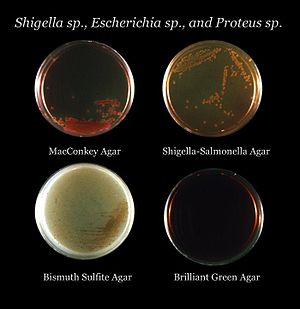
Bismuth sulfite agar is a type of agar media used to isolate Salmonella species. It uses glucose as a primary source of carbon. Bismuth and brilliant green (dye) both inhibit gram-positive growth. Bismuth sulfite agar tests the ability to use ferrous sulfate and convert it to hydrogen sulfide.
Bismuth sulfite agar typically contains (w/v):[1]
- 1.6% bismuth sulfite Bi2(SO3)3
- 1.0% pancreatic digest of casein
- 1.0% pancreatic digest of animal tissue
- 1.0% beef extract
- 1.0% glucose
- 0.8% dibasic sodium phosphate
- 0.06% ferrous sulfate • 7 water
- pH adjusted to 7.7 at 25 °C
This medium is boiled for sterility, not autoclaved.
References[edit]
- ^ Atlas, R.M. (2004). Handbook of Microbiological Media. London: CRC Press. pp. 68. ISBN 0-8493-1818-1.